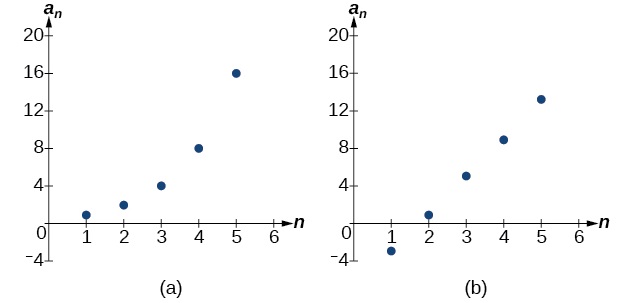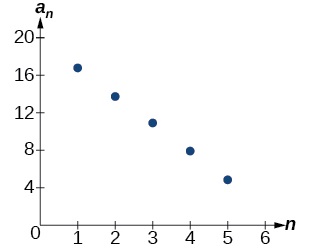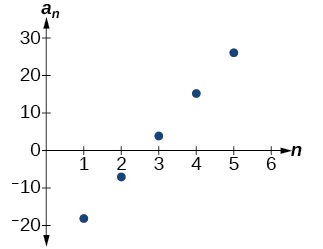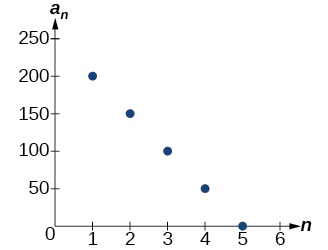11.2: Arithmetic Sequences
- Last updated
- Nov 4, 2018
- Save as PDF
- Page ID
- 13565
( \newcommand{\kernel}{\mathrm{null}\,}\)
Learning Objectives
- Find the common difference for an arithmetic sequence.
- Write terms of an arithmetic sequence.
- Use a recursive formula for an arithmetic sequence.
- Use an explicit formula for an arithmetic sequence.
Companies often make large purchases, such as computers and vehicles, for business use. The book-value of these supplies decreases each year for tax purposes. This decrease in value is called depreciation. One method of calculating depreciation is straight-line depreciation, in which the value of the asset decreases by the same amount each year.
As an example, consider a woman who starts a small contracting business. She purchases a new truck for $25,000. After five years, she estimates that she will be able to sell the truck for $8,000. The loss in value of the truck will therefore be $17,000, which is $3,400 per year for five years. The truck will be worth $21,600 after the first year; $18,200 after two years; $14,800 after three years; $11,400 after four years; and $8,000 at the end of five years. In this section, we will consider specific kinds of sequences that will allow us to calculate depreciation, such as the truck’s value.
Finding Common Differences
The values of the truck in the example are said to form an arithmetic sequence because they change by a constant amount each year. Each term increases or decreases by the same constant value called the common difference of the sequence. For this sequence, the common difference is −3,400.

The sequence below is another example of an arithmetic sequence. In this case, the constant difference is 3. You can choose any term of the sequence, and add 3 to find the subsequent term.

ARITHMETIC SEQUENCE
An arithmetic sequence is a sequence that has the property that the difference between any two consecutive terms is a constant. This constant is called the common difference. If a1 is the first term of an arithmetic sequence and d is the common difference, the sequence will be:
{an}={a1,a1+d,a1+2d,a1+3d,...}
Example 11.2.1: Finding Common Differences
Is each sequence arithmetic? If so, find the common difference.
- {1,2,4,8,16,...}
- {−3,1,5,9,13,...}
Solution
Subtract each term from the subsequent term to determine whether a common difference exists.
- The sequence is not arithmetic because there is no common difference.
2−1=14−2=28−4=416−8=8
- The sequence is arithmetic because there is a common difference. The common difference is 4.
1−(−3)=45−1=49−5=413−9=4
Analysis
The graph of each of these sequences is shown in Figure 11.2.1. We can see from the graphs that, although both sequences show growth, (a) is not linear whereas (b) is linear. Arithmetic sequences have a constant rate of change so their graphs will always be points on a line.

Q&A
If we are told that a sequence is arithmetic, do we have to subtract every term from the following term to find the common difference?
No. If we know that the sequence is arithmetic, we can choose any one term in the sequence, and subtract it from the subsequent term to find the common difference.
Exercise 11.2.1A
Is the given sequence arithmetic? If so, find the common difference.
{18,16,14,12,10,…}
- Answer
-
The sequence is arithmetic. The common difference is –2.
Exercise 11.2.1B
Is the given sequence arithmetic? If so, find the common difference.
{1,3,6,10,15,…}
- Answer
-
The sequence is not arithmetic because 3−1≠6−3.
Writing Terms of Arithmetic Sequences
Now that we can recognize an arithmetic sequence, we will find the terms if we are given the first term and the common difference. The terms can be found by beginning with the first term and adding the common difference repeatedly. In addition, any term can also be found by plugging in the values of n and d into formula below.
an=a1+(n−1)d
How to: Given the first term and the common difference of an arithmetic sequence, find the first several terms.
- Add the common difference to the first term to find the second term.
- Add the common difference to the second term to find the third term.
- Continue until all of the desired terms are identified.
- Write the terms separated by commas within brackets.
Example 11.2.2: Writing Terms of Arithmetic Sequences
Write the first five terms of the arithmetic sequence with a1=17 and d=−3.
Solution
Adding −3 is the same as subtracting 3. Beginning with the first term, subtract 3 from each term to find the next term.
The first five terms are {17,14,11,8,5}
Analysis
As expected, the graph of the sequence consists of points on a line as shown in Figure 11.2.2.

Exercise 11.2.2
List the first five terms of the arithmetic sequence with a1=1 and d=5.
- Answer
-
{1,6,11,16,21}
How to: Given any the first term and any other term in an arithmetic sequence, find a given term.
- Substitute the values given for a1, an, n into the formula an=a1+(n−1)d to solve for d.
- Find a given term by substituting the appropriate values for a1, n, and d into the formula an=a1+(n−1)d.
Example 11.2.3: Writing Terms of Arithmetic Sequences
Given a1=8 and a4=14, find a5.
Solution
The sequence can be written in terms of the initial term 8 and the common difference d.
{8,8+d,8+2d,8+3d}
We know the fourth term equals 14; we know the fourth term has the form a1+3d=8+3d.
We can find the common difference d.
an=a1+(n−1)da4=a1+3da4=8+3dWrite the fourth term of the sequence in terms of a1 and d.14=8+3dSubstitute 14 for a4.d=2Solve for the common difference.
Find the fifth term by adding the common difference to the fourth term.
a5=a4+2=16
Analysis
Notice that the common difference is added to the first term once to find the second term, twice to find the third term, three times to find the fourth term, and so on. The tenth term could be found by adding the common difference to the first term nine times or by using the equation an=a1+(n−1)d.
Exercise 11.2.3
Given a3=7 and a5=17, find a2.
- Answer
-
a2=2
Using Recursive Formulas for Arithmetic Sequences
Some arithmetic sequences are defined in terms of the previous term using a recursive formula. The formula provides an algebraic rule for determining the terms of the sequence. A recursive formula allows us to find any term of an arithmetic sequence using a function of the preceding term. Each term is the sum of the previous term and the common difference. For example, if the common difference is 5, then each term is the previous term plus 5. As with any recursive formula, the first term must be given.
an=an−1+d
for n≥2
Note: RECURSIVE FORMULA FOR AN ARITHMETIC SEQUENCE
The recursive formula for an arithmetic sequence with common difference d is:
an=an−1+d
for n≥2
How to: Given an arithmetic sequence, write its recursive formula.
- Subtract any term from the subsequent term to find the common difference.
- State the initial term and substitute the common difference into the recursive formula for arithmetic sequences.
Example 11.2.4: Writing a Recursive Formula for an Arithmetic Sequence
Write a recursive formula for the arithmetic sequence.
{−18,−7,4,15,26,…}
Solution
The first term is given as −18. The common difference can be found by subtracting the first term from the second term.
d=−7−(−18)=11
Substitute the initial term and the common difference into the recursive formula for arithmetic sequences.
a1=−18
an=an−1+11
for n≥2
Analysis
We see that the common difference is the slope of the line formed when we graph the terms of the sequence, as shown in Figure 11.2.3. The growth pattern of the sequence shows the constant difference of 11 units.

Q&A
Do we have to subtract the first term from the second term to find the common difference?
No. We can subtract any term in the sequence from the subsequent term. It is, however, most common to subtract the first term from the second term because it is often the easiest method of finding the common difference.
Exercise 11.2.4
Write a recursive formula for the arithmetic sequence.
{25,37,49,61,…}
- Answer
-
a1=25an=an−1+12, for n≥2
Using Explicit Formulas for Arithmetic Sequences
We can think of an arithmetic sequence as a function on the domain of the natural numbers; it is a linear function because it has a constant rate of change. The common difference is the constant rate of change, or the slope of the function. We can construct the linear function if we know the slope and the vertical intercept.
an=a1+d(n−1)
To find the y-intercept of the function, we can subtract the common difference from the first term of the sequence. Consider the following sequence.

The common difference is −50, so the sequence represents a linear function with a slope of −50. To find the y-intercept, we subtract −50 from 200: 200−(−50)=200+50=250. You can also find the y-intercept by graphing the function and determining where a line that connects the points would intersect the vertical axis. The graph is shown in Figure 11.2.4.

Recall the slope-intercept form of a line is y=mx+b. When dealing with sequences, we use an in place of y and n in place of x. If we know the slope and vertical intercept of the function, we can substitute them for m and b in the slope-intercept form of a line. Substituting −50 for the slope and 250 for the vertical intercept, we get the following equation:
an=−50n+250
We do not need to find the vertical intercept to write an explicit formula for an arithmetic sequence. Another explicit formula for this sequence is an=200−50(n−1), which simplifies to an=−50n+250.
Note: EXPLICIT FORMULA FOR AN ARITHMETIC SEQUENCE
An explicit formula for the nth term of an arithmetic sequence is given by
an=a1+d(n−1)
How to: Given the first several terms for an arithmetic sequence, write an explicit formula.
- Find the common difference, a2−a1.
- Substitute the common difference and the first term into an=a1+d(n−1).
Example 11.2.5: Writing the nth Term Explicit Formula for an Arithmetic Sequence
Write an explicit formula for the arithmetic sequence.
{2,12,22,32,42,…}
Solution
The common difference can be found by subtracting the first term from the second term.
d=a2−a1=12−2=10
The common difference is 10. Substitute the common difference and the first term of the sequence into the formula and simplify.
an=2+10(n−1)an=10n−8
Analysis
The graph of this sequence, represented in Figure 11.2.5, shows a slope of 10 and a vertical intercept of −8.

Exercise 11.2.5
Write an explicit formula for the following arithmetic sequence.
{50,47,44,41,…}
- Answer
-
an=53−3n
Finding the Number of Terms in a Finite Arithmetic Sequence
Explicit formulas can be used to determine the number of terms in a finite arithmetic sequence. We need to find the common difference, and then determine how many times the common difference must be added to the first term to obtain the final term of the sequence.
How to: Given the first three terms and the last term of a finite arithmetic sequence, find the total number of terms.
- Find the common difference d.
- Substitute the common difference and the first term into an=a1+d(n–1).
- Substitute the last term for an and solve for n.
Example 11.2.6: Finding the Number of Terms in a Finite Arithmetic Sequence
Find the number of terms in the finite arithmetic sequence.
{8,1,–6,...,–41}
Solution
The common difference can be found by subtracting the first term from the second term.
1−8=−7
The common difference is −7. Substitute the common difference and the initial term of the sequence into the nth term formula and simplify.
an=a1+d(n−1)an=8+−7(n−1)an=15−7n
Substitute −41 for an and solve for n
−41=15−7n8=n
There are eight terms in the sequence.
Exercise 11.2.6
Find the number of terms in the finite arithmetic sequence.
{6,11,16,...,56}
- Answer
-
There are 11 terms in the sequence.
Solving Application Problems with Arithmetic Sequences
In many application problems, it often makes sense to use an initial term of a0 instead of a1. In these problems, we alter the explicit formula slightly to account for the difference in initial terms. We use the following formula:
an=a0+dn
Example 11.2.7: Solving Application Problems with Arithmetic Sequences
A five-year old child receives an allowance of $1 each week. His parents promise him an annual increase of $2 per week.
- Write a formula for the child’s weekly allowance in a given year.
- What will the child’s allowance be when he is 16 years old?
Solution
- The situation can be modeled by an arithmetic sequence with an initial term of 1 and a common difference of 2.
Let A be the amount of the allowance and n be the number of years after age 5. Using the altered explicit formula for an arithmetic sequence we get:
An=1+2n
- We can find the number of years since age 5 by subtracting.
16−5=11
We are looking for the child’s allowance after 11 years. Substitute 11 into the formula to find the child’s allowance at age 16.
A11=1+2(11)=23
The child’s allowance at age 16 will be $23 per week.
Exercise 11.2.7
A woman decides to go for a 10-minute run every day this week and plans to increase the time of her daily run by 4 minutes each week. Write a formula for the time of her run after n weeks. How long will her daily run be 8 weeks from today?
- Answer
-
The formula is Tn=10+4n, and it will take her 42 minutes.
Media
Access this online resource for additional instruction and practice with arithmetic sequences.
Key Equations
| recursive formula for nth term of an arithmetic sequence | an=an−1+d n≥2 |
| explicit formula for nth term of an arithmetic sequence | an=a1+d(n−1) |
Key Concepts
- An arithmetic sequence is a sequence where the difference between any two consecutive terms is a constant.
- The constant between two consecutive terms is called the common difference.
- The common difference is the number added to any one term of an arithmetic sequence that generates the subsequent term. See Example 11.2.1.
- The terms of an arithmetic sequence can be found by beginning with the initial term and adding the common difference repeatedly. See Example 11.2.2 and Example 11.2.3.
- A recursive formula for an arithmetic sequence with common difference dd is given by an=an−1+d, n≥2. See Example 11.2.4.
- As with any recursive formula, the initial term of the sequence must be given.
- An explicit formula for an arithmetic sequence with common difference d is given by an=a1+d(n−1). See Example 11.2.5.
- An explicit formula can be used to find the number of terms in a sequence. See Example 11.2.6.
- In application problems, we sometimes alter the explicit formula slightly to an=a0+dn. See Example 11.2.7.
Contributors and Attributions
Jay Abramson (Arizona State University) with contributing authors. Textbook content produced by OpenStax College is licensed under a Creative Commons Attribution License 4.0 license. Download for free at https://openstax.org/details/books/precalculus.


